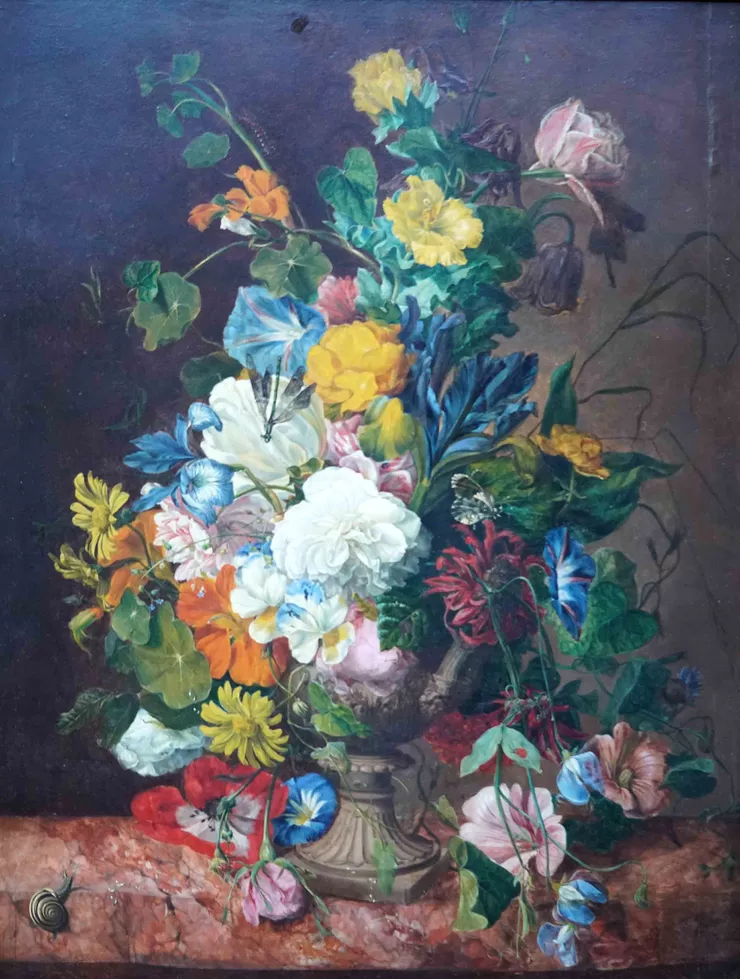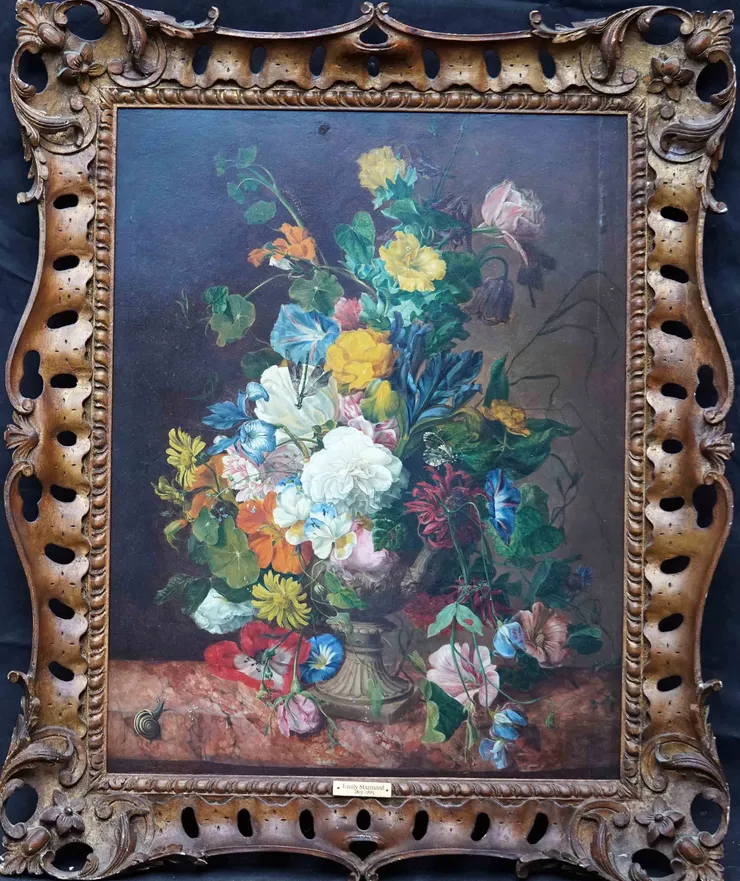Emily Stannard (1802-1885)
| Artist Name | Emily Stannard (1802-1885) |
|---|---|
| Title | Still Life of Flowers on Marble Ledge |
| Description | This stunning 19th century still life floral oil on panel painting is by noted still life female Norwich School artist Emily Stannard. Emily Stannard and her niece Eloise Harriet Stannard are nowadays considered to be among the most accomplished British women still life painters of the 19th century. Stannard is associated with the Norwich School of painters. She also travelled to Holland to study Dutch art and was given permission to copy Jan van Huysum's work which was then highly praised. She had a long and distinguished career as an artist and many of her works are house in Norfolk Museums. Painted circa 1840, this lovely composition is a naturalistic floral arrangement in an urn on a marble ledge. The flowers are a mix of whites, pinks and blues with some geraniums, roses, daisies and mallow. There is a beautifully detailed dragonfly and butterfly as well as a little snail on the marble ledge. One side of the background is darker than the other which shows of the flowers against it to great effect. The colours are vibrant and brush work detailed. This painting is a fantastic example of Stannard's work and clearly shows how well she deserved her superb reputation as being one of the most accomplished female 19th century still life painters. |
| Provenance | Oscar and Peter Johnson Gallery, London |
| Medium | Oil on Canvas |
| Size | 15 x 20 inches |
| Frame | Housed in a beautiful gilt swept cradled frame, 27 inches by 22 inches and in good condition. |
| Condition | Good condition. |
| Biography | Emily Stannard (née Emily Coppin; 8 February 1802 – 6 January 1885), who from 1826 called herself (even during her long widowhood) Mrs Joseph Stannard, was a British still life painter. She was associated with the Norwich School of painters, Britain's first provincial art movement. Along with her niece Eloise Harriet Stannard, she is considered to be the most accomplished British female still life artist of the 19th century. Stannard was born in Norwich of artistic parents. In 1820, she travelled with her father Daniel Coppin to the Netherlands to study the paintings of Jan van Huysum and other Dutch masters, an episode which influenced her artistic style. She married the Norwich artist Joseph Stannard in 1826, but was widowed four years later. She painted until she was in her eighties, mainly depicting paintings of flowers in vases, fruit or game animals. She exhibited in both Norwich and London, and was awarded a large gold medal in 1820 for an original painting of flowers, and two further gold medals in later years. She became an honorary member of the Norwich Society of Artists in 1831. Her works were favourably received by the local press during her lifetime, and in recent decades, art historians have praised the highly finished appearance of her paintings and her use of colour. The largest collection of works by Stannard are held by the Norfolk Museums Collections, based at Norwich Castle. Her works were shown at an exhibition of paintings by her family held in Norwich in 1934, and she was among those women artists featured in 2018 and 2019, at the exhibition Visible Women at Norwich Castle. Stannard is associated with the Norwich School of painters, which was, according to the art historian Andrew Moore, "a unique phenomenon in the history of 19th-century British art." Norwich was the first English city outside London where a school of artists arose. Its most important members were John Crome and John Sell Cotman—the leading spirits and finest artists of the movement as well as Joseph Stannard, James Stark, George Vincent, Robert Ladbrooke and Edward Thomas Daniell, the best etcher of the school. The Norwich School artists were connected by geographical location, their depiction of Norwich and rural Norfolk, and by close personal and professional relationships. By the end of the 19th century their paintings, which had once been regarded as modern and progressive, were seen as belonging to a bygone age, a view that Andrew Hemingway has attributed to the "mythology of rural Englishness" that prevailed at the start of the 20th century. The Norwich Society of Artists was founded in 1803. Members of the Stannard family showed their pictures at the Society's exhibitions, but they had few other artistic connections with their Norwich contemporaries. Emily Stannard became an honorary member in 1831, and was the only individual in her family to have a formal association with the Society. Emily Coppin was born on 8 February 1802 in Norwich, the daughter of Daniel Coppin and his wife Elizabeth Clyatt. Both her parents were accomplished amateur artists. Daniel Coppin was a collector and a founding member of the Norwich Society of Artists. Elizabeth Coppin was a talented copyist who was twice honoured with a medal by the Norwich Society. Little is known of Coppin's childhood or education. In 1820, she travelled with her father to Holland to study Dutch painting, which greatly influenced her subsequent work. During her visit, she obtained permission to copy paintings by the Dutch Master Jan van Huysum at Trippon House, Amsterdam, and her work was praised for its accuracy. There, according to her obituary, "she complied with the conditions laid down by showing two specimens of her painting, the President of the Amsterdam Gallery, Mons. Apostal, expressing great satisfaction with her work, and she was allowed to make a copy of another Van Huysum". Coppin met and got to know her fellow artist Joseph Stannard in 1820 when attending meetings of the Norwich Society of Artists, On 3 January 1826, with Emily already an established artist who had exhibited works, they were married at St George's, Tombland in Norwich. They were a well-matched couple, with both coming from artistic backgrounds. Their daughter Emily was born in 1827. Their second child Harriet Augusta died in March 1830, aged nine months. The marriage was short-lived, for Joseph Stannard died of tuberculosis in 1830 at the age of thirty-three, despite the efforts of his wife, who tried many doctors and treatments in an attempt to save him. She was to outlive him by over half a century. Their daughter Emily was a still life painter and a teacher, who exhibited with the Norfolk and Norwich Association in 1856 and the Norwich Industrial Exhibition in 1867. Their niece Eloise Harriet Stannard and Eloise's younger brother Alfred George Stannard were both notable artists, as was Joseph's brother Alfred Stannard. Stannard lived as an artist and a teacher in Norwich for over 50 years, during which time her paintings received favourable reviews in the press. Stannard had a studio in the city in Rose Lane. During her last years she lived at 12 Cathedral Street with her unmarried daughter Emily, and died there on 6 January 1885. Stannard's early paintings were influenced by the Dutch masters; both her representation of vases and the finish of her depiction of flowers owed much to Huysum, and her unsigned works were sometimes attributed to 18th century Dutch painters. Her Still life: Dead Ducks and a Hare with a Basket and Sprig of Holly reveals a debt to Jan Weenix, whose work Dead Hare and Partidges was presumably seen by her when it was exhibited at the British Institution. Paintings by Dutch masters at country houses in Norfolk (such as at Wolterton Hall) may also have been available for her to view. Stannard, assisted by her daughter, had a long career as an art teacher. During Stannard's artistic career, which continued until shortly before her death, she depicted flower bouquets in vases and other traditional still life paintings of tableware, fruit or game animals, in front of plain backgrounds. She first exhibited her works in 1816. In 1821, aged 17, she was awarded the Norwich Society of Artists' gold medal for one of her paintings of flowers. By 1824 she has established her eminence as a still life artist. In 1822 she won a second medal for a still life of a collection of fruit, and a third medal in 1828 for a painting of game animals, which was exhibited at the Norwich Society of Artists as Dead Game from Nature. She exhibited 22 pictures at the Norwich Society of Artists from 1816 to 1825. Her paintings were shown at the Norfolk and Suffolk Institution, the Norwich & Norfolk Art Union, the Norwich & Norfolk Association, the Norwich Art Loan Exhibitions, and the Norwich Fine Art Association. Although she usually exhibited her work in Norwich, from 1823 to 1825 she showed paintings at the Royal Society of British Artists the British Institution in London. On at least one occasion Stannard signed a painting 'Emily Stannard', but her works are more usually signed 'Mrs. Joseph Stannard'. Her canvasses, which were often left unvarnished, were consistently painted with a thin, diluted paint, in a similar way to the works of the Dutch masters she studied. Stannard received good local press reviews of her works throughout her career. In 1823 the Norwich Mercury wrote of her that "she is an honour to art, an honour to the city, and an honour to her sex, by the taste, industry, and knowledge, her beautifully disposed and elaborately finished pictures display." Her obituary appeared in the local press the week following her death, mentioning that "Mrs. Stannard had a great artistic merit, was a very clever painter of fruit, flowers, fish, game, and still life, and her pictures have always been highly esteemed by lovers of art", and describing "her kindly, gentle, modest, and simple nature (which) endeared her to all who had the pleasure of her acquaintance". Emily Stannard and her niece Eloise Harriet Stannard are nowadays considered to be among the most accomplished British women still life painters of the 19th century. The Norfolk Museums Collections is the only United Kingdom public art collection which possesses works by Stannard. Her paintings there are: Still life: hamper with dead wood pigeon and leveret; Still life: dead ducks and a hare with a basket and a sprig of holly (1853); Still life with dead game and a flagon and a string of onions (1847); Dead game and a gun (1835); Dead game (1837); Flowers; Still life: group of dead game birds; and Wild duck (study). Stannard's works were shown at the Norwich Castle Museum Stannard Exhibition in 1934. She was among those women artists represented at the exhibition Visible Women at Norwich Castle in 2018 and 2019. |
| Price | SOLD |

